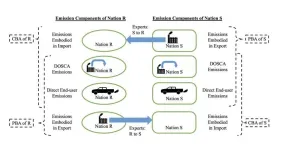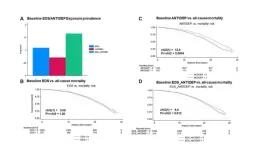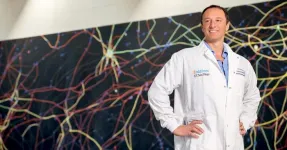(Press-News.org) Income inequality and carbon dioxide emissions for high-income nations such as the United States, Denmark and Canada are intrinsically linked – but a new study from Drexel University has taken a deeper look at the connection and found this relationship is less fixed, can change over time, and differ across emission components. The findings could help countries set a course toward reducing emissions of the harmful greenhouse gas and alleviating domestic income inequality at the same time.
The study, conducted by Xiaorui Huang, PhD, an assistant professor in the College of Arts and Sciences, applies a multidimensional emissions profile (MEP) framework to examine how the relationship between income inequality and emissions can differ by category of human activity.
The study, published in Social Forces, considers four emission components — carbon dioxide-emitting activities — with distinct implications for climate change mitigation, using data from 34 wealthy nations between 2004-2015:
emissions generated by domestic-oriented supply chain activities
emissions embodied in exports
direct emissions of end-user activities
emissions embodied in imports
These components are identified as distinct points of intervention for climate change mitigation, and they are interconnected via domestic and global supply chains. Huang applied MEP framework to investigate how these four emission components may be heterogeneously related to nations’ income inequality. The multidimensional analysis identifies emission components that may be mitigated by inequality-reducing policies — synergy— and emission components that may grow due to such policies — trade-offs.
The research employed statistical models to examine the link between carbon dioxide emissions and the income share of the top 10% of a country’s population – a measure capturing the concentration of income at the top of the distribution. Huang found that the income share of the top 10% is negatively related to direct end-user emissions from 2009 to 2011 following the Great Recession, and positively related to emissions embodied in exports from 2011 to 2015.
“I theorize that direct end-user emissions and emissions embodied in exports are related to the top 10% income share via different mechanisms,” Huang said.
Prior research establishes three co-existing theoretical mechanisms: power and political economy, how income inequality shapes consumption patterns or the ‘Veblen effect’, and households’ marginal propensity to emit.
“The political economy mechanism focuses on how income concentration at the top of the distribution empowers the wealthy to undermine regulations on carbon emissions from general production activities including export-oriented industries,” said Huang. “Income share of the top 10% is related to emissions embodied in exports via the political economy mechanism, which became more pronounced from 2011 to 2015.”
“In contrast, the ‘Veblen effect’ and the marginal propensity mechanisms are more closely linked to consumption activities: the former concerns how domestic income inequality spurs competitive and emulative consumption, while the latter concerns the societal distribution of households at different income levels with varying marginal propensity to spend additional income and emit CO2 as a result,” said Huang. “Income inequality is related to direct end-user emissions through these two mechanisms—the strength of which changed due to the Great Recession of 2008, resulting in the negative relationship from 2009 to 2011.”
The paper suggests that reducing income concentration at the top end of the distribution could synergistically reduce emissions embodied in exports, but might increase direct end-user emissions at times, such as during and immediately after a recession.
“To mitigate the dual crises of climate change and growing economic inequality, it is vital to enhance the synergy between CO2 emissions abatement and inequality reduction,” said Huang.
Huang suggests that these insights can guide policy efforts to improve the synergy while minimizing the trade-offs. Inequality-reducing policies – one example currently being considered is a global tax on billionaires – should be implemented along with measures that improve the well-being of lower-income populations without causing inadvertent growth in their direct fossil fuel consumption.
Read the full paper here: https://academic.oup.com/sf/advance-article-abstract/doi/10.1093/sf/soae074/7681807?redirectedFrom=fulltext
END
Income inequality and carbon dioxide emissions have a complex relationship
New Drexel University study is the first to use a multidimensional framework – finding domestic income inequality unevenly impacts different emission components in wealthy nations
2024-06-10
ELSE PRESS RELEASES FROM THIS DATE:
Yuan elevated to IEEE senior member
2024-06-10
Jinghui Yuan, an R&D staff member in the Applied Research for Mobility Systems group at the Department of Energy’s Oak Ridge National Laboratory, has been elevated to a senior member of the Institute of Electrical and Electronics Engineers, or IEEE.
Senior member status is the highest grade of IEEE and requires extensive experience that reflects professional accomplishments. Only 10% of IEEE’s more than 450,000 members achieve this level.
As a transportation engineer in the Buildings and Transportation Science Division, Yuan’s research focuses on intelligent transportation systems, crash risk prediction, big data analytics, deep learning, traffic simulation and ...
Passive heat exposure increases stress on the heart, posing risk to adults with history of CAD
2024-06-10
Embargoed for release until 5:00 p.m. ET on Monday 10 June 2024
Annals of Internal Medicine Tip Sheet
@Annalsofim
Below please find summaries of new articles that will be published in the next issue of Annals of Internal Medicine. The summaries are not intended to substitute for the full articles as a source of information. This information is under strict embargo and by taking it into possession, media representatives are committing to the terms of the embargo not only on their own behalf, but also on behalf of the organization they represent.
----------------------------
1. ...
Feeling rough after your COVID shot? Congrats, it’s working!
2024-06-10
Feeling Rough After Your COVID Shot? Congrats, It’s Working!
Headache, chills, tiredness may be evidence of a supercharged defense, according to UCSF-led study.
Fewer than 1 in 4 people in the United States have received last year’s updated COVID-19 vaccine, despite a death toll of more than 23,000 Americans this year.
One of the most common reasons for bypassing the COVID vaccine is concern about side effects like tiredness, muscle and joint pain, chills, headache, fever, nausea and feeling generally unwell. But a new study, led by UC San Francisco, has found that the symptoms indicate a robust immune response that is likely to ...
Depression, antidepressants, epigenetic age acceleration, and mortality in postmenopausal women
2024-06-10
“The study examined the impact of depressive symptoms, antidepressant use, and epigenetic age acceleration on all-cause mortality in postmenopausal women.”
BUFFALO, NY- June 10, 2024 – A new research paper was published in Aging (listed by MEDLINE/PubMed as "Aging (Albany NY)" and "Aging-US" by Web of Science) Volume 16, Issue 10, entitled, “Relationships of depression and antidepressant use with epigenetic age acceleration and all-cause mortality among postmenopausal women.”
In this new study, researchers May A. Beydoun, Hind A. Beydoun, Jason Ashe, Michael F. Georgescu, Steve Horvath, Ake Lu, Anthony S. Zannas, ...
Researchers engineer new approach for controlling thermal emission
2024-06-10
UNIVERSITY PARK, Pa. — If a material absorbs light, it will heat up. That heat must go somewhere, and the ability to control where and how much heat is emitted can protect or even hide such devices as satellites. An international team of researchers, including those from Penn State, has developed a novel method for controlling this thermal emission, with what they called promising implications for thermal management and thermal camouflage technologies.
The team published their work on June 7 in the print edition of Science.
Led by researchers at The University of Manchester’s National Graphene Institute ...
UTA honors two faculty for distinguished scholarship
2024-06-10
The University of Texas at Arlington is honoring two faculty for their outstanding contributions to scholarship with the Distinguished Record of Research or Creativity Award.
Sam W. Haynes, professor of history, and Jaehoon Yu, professor of physics, are the 2024 recipients of the award, which recognizes faculty who have achieved a distinguished record of scholarship over an extended period.
“Jae and Sam have each been at UTA for more than 20 years, and they have each truly made an impact in the lives of the students we prepare for future careers,” said Kate C. Miller, vice president of research and innovation. "In addition, their contributions ...
New research describes the leisure motivations that underpin young U.S. adults' recreational cannabis use
2024-06-10
As of 2024, 24 states including Virginia and Maryland, and DC have legalized the adult recreational use of cannabis. As laws change, citizens' perceptions of the drug and reasons for using the drug have also shifted. In 2020, 34.5% of adults aged 18-25 reported using cannabis in the previous 12 months, according to the Substance Abuse and Mental Health Services Administration. Health experts seek to better understand the broader implications of legalizations and individuals’ motivations and attitudes related to cannabis use.
New ...
UC San Diego develops first-in-kind protocol for creating ‘wired miniature brains’
2024-06-10
Researchers worldwide can now create highly realistic brain cortical organoids — essentially miniature artificial brains with functioning neural networks — thanks to a proprietary protocol released this month by researchers at the University of California San Diego.
The new technique, published in Nature Protocols, paves the way for scientists to perform more advanced research regarding autism, schizophrenia and other neurological disorders in which the brain’s structure is usually typical, but electrical activity is altered. That’s according to Alysson Muotri, Ph.D., corresponding author and ...
Lone Star State: Tracking a low-mass star as it speeds across the Milky Way
2024-06-10
It may seem like the Sun is stationary while the planets in its orbit are moving, but the Sun is actually orbiting around the Milky Way galaxy at an impressive rate of about 220 kilometers per second — almost half a million miles per hour. As fast as that may seem, when a faint red star was discovered crossing the sky at a noticeably quick pace, scientists took notice.
Thanks to the efforts of a citizen science project called Backyard Worlds: Planet 9 and a team of astronomers from around the country, a rare hypervelocity ...
Researchers demonstrate the first chip-based 3D printer
2024-06-10
CAMBRIDGE, MA – Imagine a portable 3D printer you could hold in the palm of your hand. The tiny device could enable a user to rapidly create customized, low-cost objects on the go, like a fastener to repair a wobbly bicycle wheel or a component for a critical medical operation.
Researchers from MIT and the University of Texas at Austin took a major step toward making this idea a reality by demonstrating the first chip-based 3D printer. Their proof-of-concept device consists of a single, millimeter-scale photonic ...
LAST 30 PRESS RELEASES:
Making lighter work of calculating fluid and heat flow
Normalizing blood sugar can halve heart attack risk
Lowering blood sugar cuts heart attack risk in people with prediabetes
Study links genetic variants to risk of blinding eye disease in premature infants
Non-opioid ‘pain sponge’ therapy halts cartilage degeneration and relieves chronic pain
AI can pick up cultural values by mimicking how kids learn
China’s ecological redlines offer fast track to 30 x 30 global conservation goal
Invisible indoor threats: emerging household contaminants and their growing risks to human health
Adding antibody treatment to chemo boosts outcomes for children with rare cancer
Germline pathogenic variants among women without a history of breast cancer
Tanning beds triple melanoma risk, potentially causing broad DNA damage
Unique bond identified as key to viral infection speed
Indoor tanning makes youthful skin much older on a genetic level
Mouse model sheds new light on the causes and potential solutions to human GI problems linked to muscular dystrophy
The Journal of Nuclear Medicine ahead-of-print tip sheet: December 12, 2025
Smarter tools for peering into the microscopic world
Applications open for funding to conduct research in the Kinsey Institute archives
Global measure underestimates the severity of food insecurity
Child survivors of critical illness are missing out on timely follow up care
Risk-based vs annual breast cancer screening / the WISDOM randomized clinical trial
University of Toronto launches Electric Vehicle Innovation Ontario to accelerate advanced EV technologies and build Canada’s innovation advantage
Early relapse predicts poor outcomes in aggressive blood cancer
American College of Lifestyle Medicine applauds two CMS models aligned with lifestyle medicine practice and reimbursement
Clinical trial finds cannabis use not a barrier to quitting nicotine vaping
Supplemental nutrition assistance program policies and food insecurity
Switching immune cells to “night mode” could limit damage after a heart attack, study suggests
URI-based Global RIghts Project report spotlights continued troubling trends in worldwide inhumane treatment
Neutrophils are less aggressive at night, explaining why nighttime heart attacks cause less damage than daytime events
Menopausal hormone therapy may not pose breast cancer risk for women with BRCA mutations
Mobile health tool may improve quality of life for adolescent and young adult breast cancer survivors
[Press-News.org] Income inequality and carbon dioxide emissions have a complex relationshipNew Drexel University study is the first to use a multidimensional framework – finding domestic income inequality unevenly impacts different emission components in wealthy nations





